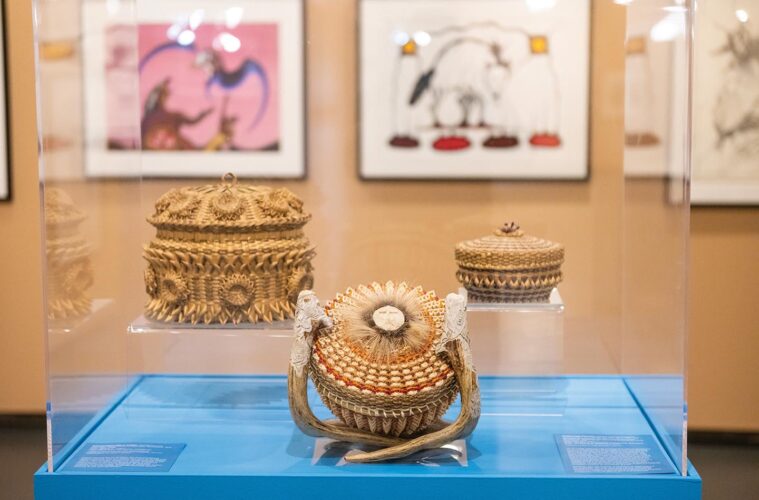Picker Art Gallery’s new exhibition centers contemporary Indigenous artists.
Dozens of brightly colored paintings line the walls of the Picker Art Gallery — some depict people, animals, or landscapes, while others display inventive combinations of all three. No two pieces are the same; each work illustrates unique colors and forms, each tells a different yet interconnected story.
Picker Art Gallery’s current exhibition, Living Legends: The Indigenous Art of Storytelling, draws on artworks from the Longyear Museum of Anthropology and focuses on artists from the Great Lakes region. These works span a range of media, from paintings in the Woodland style to prints, sculptures, photo collages, and handwoven black ash baskets.
One painting comes from Anishinaabe artist Norval Morrisseau (also known as Copper Thunderbird), who was a pioneer of the Woodland style of painting, a style characterized by bright colors and bold outlines.
“Morrisseau drew on the legends of the Anishinaabe people and depicted them for the first time for non- Indigenous audiences,” explains Co-Director of University Museums and Curator of Picker Art Gallery Nick West, who organized the exhibition with a team of students. “This caused controversy in [Morrisseau’s] community but also opened a door for First Nations artists to start showing their work in contemporary spaces.”
With the majority of the pieces on loan from the Longyear, the exhibition at the Picker addresses the history of how Indigenous artwork has been othered. “How should pieces of Indigenous artwork such as these be treated in museum spaces?” asks West, gesturing to a display of intricate black ash “fancy” baskets. “Works such as these take an enormous amount of labor, and their artistry is undeniable. Museums have tended to pigeonhole this art into categories of craft or ethnology, but these artists are part of a global contemporary art discourse.”
The exhibition features several artworks by Haudenosaunee artists, including Ronni-Leigh Goeman (Onondaga) and Stonehorse Goeman (Seneca). The two have been working together to create their basketry for more than 25 years, with Ronni-Leigh weaving the intricate bodies of the baskets and Stonehorse sculpting the handles, stands, and carved ornamentation.
“Basketry is an important part of our lifestyle, as it is an ancestral art form,” says Ronni-Leigh. “These particular baskets tell a story. My hope is that [people] will recognize that these baskets represent both our past and present and the beauty of our culture.”
Audrey Chan ’23, one of the student curators who helped to organize the exhibition, views Living Legends as a chance for visitors to appreciate both Indigenous artwork and the artists behind it. “Not only is Living Legends an opportunity to see works never before displayed at Picker Art Gallery, but it is also a multidimensional experience comprising anecdotes of celebration, tragedy, and resilience in the lives and art of Native American artists,” Chan says.
Also at Picker, as part of his ongoing Art-i-fact series, artist Cannupa Hanska Luger created an exhibition titled Rounds. The installation comprises 72 ceramic sculptures modeled after ammunition, which have then been painted to appear as divergent from weaponry as possible. The deeper visitors get into the gallery, the more contradictory the ceramic rounds appear, transforming from weapons of war into delicate china-patterned pieces, vibrant crayon-esque spires, and stately sculptures of white and gold. Through viewing these reimagined rounds, Luger encourages his audience to consider what is lost and what is gained when form triumphs over function and how this relates to how we view Indigenous art.
“Indigenous artwork has historically been commodified and viewed by white tourists as souvenirs,” West says. “But these works have rich history and meaning that get lost when their form is valued over their function.”
Living Legends: The Indigenous Art of Storytelling and Rounds will be on display through June 26.

